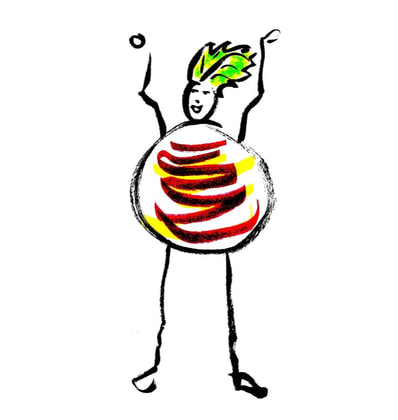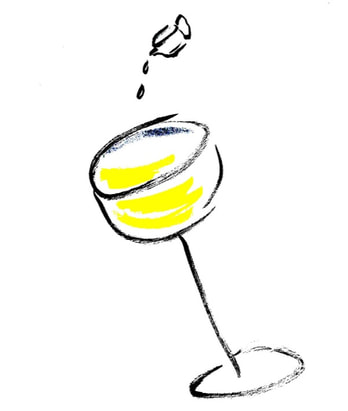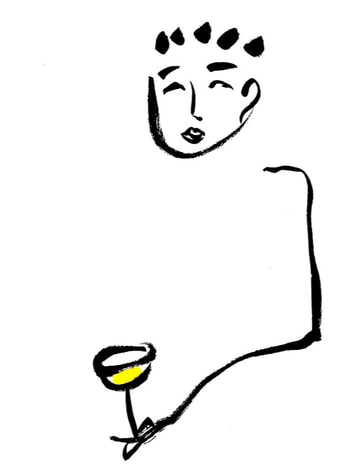 Many great Bordeaux wines are full-bodied personalities with nuanced, complex flavors and a long finish. Many great Bordeaux wines are full-bodied personalities with nuanced, complex flavors and a long finish. Most wines are of a medium body. Our reflections today, however, deal with opposite ends of the spectrum: lean, dancing-on-the-tongue, light-bodied wines verses rich, full-bodied examples. One is a ballet star, the other, a sumo wrestler. Do you have a favorite? In the world of light- verses full-bodied wines, one is not better than the other. They simply offer different experiences. Many of the world’s greatest wines, such as high-quality Bordeaux examples, are full-bodied personalities that deliver nuanced, complex flavors and a long finish. You think of these full-bodied wines, many of them primarily composed of Cabernet Sauvignon and Merlot, as having the stuffing needed for aging gracefully (medium to high alcohol, tannins, fruit concentration, etc.). Northeast of Bordeaux are the great reds of Burgundy, focused on Pinot Noir. These wines show off a completely different body type: lithe, light, and just as nuanced and complex as their Bordelaise counterparts. To understand the difference between full-bodied and light-bodied wines, think about the difference between whole milk and skim milk. It is a matter of viscosity. A full-bodied wine has weight and texture in the mouth. We tend to drink full-bodied wines more slowly, possibly because the mouthfeel captures our attention or the mechanics of drinking a full-bodied wine are more complex than those of light-bodied quaffs. Rich, full-bodied wines are especially attractive in the winter and with heartier meals, such as roast beef, while lean, delicate wines are just the ticket for lighter fare, such as red snapper with lemon slices and herbs baked in parchment packets, served in the heat of summer on a deck overlooking the ocean. Not surprisingly, there are exceptions to these commonly accepted pairing guidelines. For instance, some crisp and lean whites, such as dry Rieslings from Australia, with their dancing acidity, can work well to cut through the fats of heavy meals, even steak. That type of match is unconventional, but if it pleases your palate, who’s to say it is wrong? As a winemaker, I have found that it takes more skill to make a top-quality light-bodied wine than a full-bodied one. Grapes used for full-bodied wines are typically bursting with concentrated fruit flavors, with the reds often sporting a dash of spice from time in oak as well as firm tannins. These bold, beefy wines interact with your palate at full volume, with the possibility of masking flaws such as smoke taint, Brettanomyces or volatile acidity. Makers of light-bodied wines have no place to hide such flaws. A lean wine can also have concentrated fruit flavors, spice, and tannins, but because it lacks the “clothing” of a much richer wine, you can more easily unveil its secrets. Light wines are naked to your observation, broadcasting the quality of the grapes, vintage vagaries, mistakes made in the cellar by the winemaker, or poor storage issues. Winemakers can increase the body of any wine, red or white, through oak aging, fortification, back-sweetening and other production techniques. Conversely, a wine’s body can be lightened through fermentation practices, adding water or other liquids, and blending. A lean wine can also have concentrated fruit flavors, spice, and tannins, but because it lacks the “clothing” of a much richer wine, you can more easily unveil its secrets. When you are in the mood for a full-bodied wine, you might first think of reaching for a red. Inky reds set the tone for a brooding drink as you cozy up to the fireplace to discuss your world domination plans with a respected mentor. However, you might be selling yourself short if you neglect to consider a full-bodied white. Certain white varieties, such as Viognier and Marsanne, have characteristics that lend themselves to the production of rich and lush wines that are ideal for heavier meals and conversations. When the winemaker has the budget and time, a white can achieve further richness through techniques in the cellar that might include letting the wine rest on lees (spent yeast), barrel fermentation, oak aging, malolactic fermentation, and skin contact (the making of a white wine usually involves separating the skins from the grape immediately after harvesting; leaving the skins on for some degree of time adds texture).  White wines that have gone through malo often emit dairy aromas such as cream or butter. White wines that have gone through malo often emit dairy aromas such as cream or butter. Malolactic fermentation (malo) is a process where a wine’s tart malic acid is converted to softer, creamier lactic acid, resulting in a more rounded, full and mellow texture in the mouth. Malo occurs in most reds, taming the astringency of the tannins, and in some whites. White wines that have gone through malo often emit dairy aromas such as butter or cream, with an iconic example being a classic Napa Valley Chardonnay. Winemakers who want a leaner, crisper style of white, such as a New Zealand Sauvignon Blanc, block malo by using sulfur dioxide or by cooling down the wine to around fifty degrees. The bottom line: malo fills out and mellows a wine, and this certainly affects our perception of body type. My personal selection of a wine, light- or heavy-bodied (or anywhere in-between), depends on the situation at hand. The selection of a wine can involve creativity, practicality, and strategy. Select the best bottle to convey the mood and scenario, much like a lighting director might use her creative talents to help a film director tell a compelling story. Recently a good friend called to tell me she had lost her beloved family dog and was hoping for some company. Which bottle would you have under arm for this delicate situation? Please allow me to escort you at this very moment to my cellar and we will make our selection. Oh, are you surprised to see that my “cellar” is actually an under-the-counter wine fridge in the kitchen that is always crammed full? Do we choose that Vino Rosato by Andrea Scovero on the top shelf? No . . . too light for the occasion. Let’s reach instead to the lower shelf for the 2019 Provins “Chandra Kurt” Cornalin from Valais, Switzerland. This is a rich, aromatic, fruity and juicy red with a kiss of bitterness at the finish. See that bottle right next to the Cornalin? Grab it also, please. This is a 2019 Ciro Picariello Fiano di Avellino. It should be just right if my friend prefers a white. Some people only drink white wine during the day; it conforms with their vision of propriety. Perhaps my friend fits into that category, now that I think back to our past wine adventures, and I like to be ready for anything. Many people drink exclusively reds or whites, passing up the opportunity to enjoy the full spectrum of what wine has to offer. What a shame. People often ask me to name my favorite type of wine, to which I answer, “They are all my children, I love them equally.” In any case, we are fully prepared with these beautiful specimens. What causes a full or light body? The amount of alcohol in the wine is one key indicator of a wine’s body. Wines with up to twelve-and-a-half percent alcohol by volume are generally considered to be light-bodied. Medium-bodied wines, which are not covered in this list, are generally between twelve-and-a-half to thirteen-and-a-half percent alcohol. Wines with high alcohol levels, those at fourteen percent and above, are full-bodied, and that would be another reason why we tend to drink these wines more slowly than their lighter counterparts. The amount of alcohol in a wine does not, in all cases, indicate the body type. A sweet wine such as a Canadian Icewine or a German Beerenauslese can be low in alcohol (as low as seven percent) yet full-bodied because fermentation was halted by the winemaker before the yeast could eat all the sugars. In that case, the yeast did not convert all of the sugars into alcohol, leaving the wine sweet with residual (leftover, unfermented) sugars to produce a wine that is rich and full-bodied. In our Canadian and German examples, the body type is trickier to identify strictly by the alcohol level; we rely more on a wine’s texture in the mouth rather than the alcohol to give a precise assessment of the body. Sugar adds to our impression of body while acidity lightens up our feel. There is yet another naturally occurring chemical that affects our perception of a wine’s texture, mouthfeel and body: glycerol, also known as glycerine. When the yeast goes to work during fermentation, mostly producing ethanol and carbon dioxide, glycerol is next in line in terms of output. It is colorless and odorless but enhances a wine’s quality and sensory properties by contributing elements of sweetness and fullness. The amount of glycerol produced depends upon the yeast strain, the amount of sugar in the must (unfermented grapes), the grape varietal, and the ripeness of the grapes, among other things. If you would like to experience higher than normal glycerol levels in a wine, try Amarone, produced in Italy’s Veneto region, where glycerol contributes a splendid perception of sweetness and fullness even if the wine finishes dry.  Some people only drink white wine during the day; it conforms with their vision of propriety. Some people only drink white wine during the day; it conforms with their vision of propriety. A region’s climate can provide you with possible indicators of a wine’s body. Grapes need warmth and sunlight in the vineyard, among other factors, to convert their sugars into alcohol. Grapes grown in a more northerly latitude (or at a higher altitude) struggle to obtain ripeness as they must deal with cooler weather, overcast days and weaker sunlight. Examples of cool weather regions include Champagne, France; Wachau, Austria and Valais, Switzerland. When grapes skirt the edge of ripeness, they reach lower sugar levels which translates to less alcohol and a corresponding leaner body. In some cases, grape varieties structure themselves to adapt to cool climates by developing thinner skins to soak up as much sun as possible inside the grape to advance ripening. These grapes typically have lower alcohol levels, lighter tannins, and more acidity, all hallmarks of light-bodied wines. Tannins contribute to our perception of body, and in cool climates, grapes struggle to fully develop tannins. (Underripe tannins can make a wine taste green, sour or astringent.) Grapes grown in areas blessed with sunlight and warmth have no problem ripening. They easily convert the grape’s sugars to high alcohol levels and therefore lower acidity. Tannins will develop fully, paving the way for the production of wines with a full and generous body. Wine regions with Mediterranean climates such as France’s Languedoc, Sardinia’s Gallura, and California’s Napa Valley come to mind. In such climates, grapes need protection from the heat of the sun to avoid over-ripening and shriveling on the vine. Grapes that get too ripe usually produce wines that are very high in alcohol with overly jammy flavors and possibly a flabby mouthfeel. Some varieties adapt to the heat by growing thicker skins to prevent sunburn, and thicker skins contribute to a sensation of body in the mouth in the form of robust tannins. Several grape varieties are elastic in personality, such as Zinfandel, Chardonnay, Chenin Blanc, and Riesling, and lend themselves to production in multiple body classes. What’s more, a winemaker can elect to use a grape variety that is typically made in a lean style and go the opposite direction, pushing for a fuller style, or the other way around. An example of this is Picpoul de Pinet, which is usually produced in a light, zippy style. As this grape varietal grows in popularity, winemakers in France, California and Texas are employing production methods such as barrel fermentation to broaden the flavor profile and body. Light-Bodied Varieties Whites: Albariño Aligoté Chardonnay (Chablis) Chasselas Cortese Dafni Friulano Garganega (Soave and Gambellara) Grenache Blanc Grüner Veltliner Loureiro Melon de Bourgogne (Muscadet) Moschofilero Müller-Thurgau Muscat Blanc/Moscato Picpoul de Pinet Pinot Blanc Pinot Grigio/Pinot Gris Reisling (Mosel) Sauvignon Blanc Verdicchio Xarel-lo Reds: Blaufränkisch/Lemberger Cinsaut/Cinsault Corvina Counoise Frappato Gamay Pinotage Pinot Noir Poulsard/Ploussard Primitivo/Zinfandel Schiava St. Laurent Zweigelt Full-Bodied Varieties Whites: Arneis Assyrtiko Chardonnay (Napa Valley) Coda di Volpe Fiano Gewürztraminer Godello Greco Grenache Blanc Kerner Marsanne Petit Manseng Roussanne Sémillon/Semillon Silvaner/Sylvaner Timorasso Verdejo Viognier Reds: Aglianico Cabernet Sauvignon Carménère Cornalin Garnacha/Grenache Lagrein Malbec Merlot Mourvèdre/Mataro/Monastrell Nebbiolo Negroamaro Nero D’Avola Petite Sirah Petit Verdot Refosco (Colli Orientali) Regent Ruchè Susumaniello Syrah/Shiraz Tannat Touriga Nacional This is one in a series of Grape Detective blogs featuring the attributes of wine and how your love for a specific wine grape may lead you to discover new grapes with similar characteristics. The focus of the list is grape variety and does not include blends, wine regions, or styles.
0 Comments
Leave a Reply. |
AuthorLyne Noella Archives
October 2022
Categories
All
|


 RSS Feed
RSS Feed
